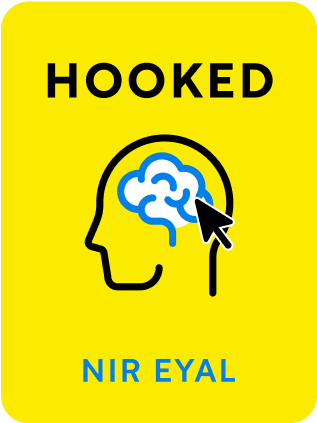

This article is an excerpt from the Shortform summary of "Hooked" by Nir Eyal and Ryan Hoover. Shortform has the world's best summaries of books you should be reading.
Like this article? Sign up for a free trial here .
What are products that solve problems? How does a problem-solving product improve your business outlook?
Products that solve problems are advantageous because customers need them. When a product improves someone’s life, you’re more likely to get customer loyalty.
Read more about products that solve problems and why you should aim to have a problem-solving product.
Why Do People Return to Some Products?
Modern technology has us addicted to its use. Cognitive psychologists define habits as “automatic behaviors triggered by situational cues,” and app/tech product usage clearly qualifies in many cases.
Companies that are better at building usage habits are at a clear economic advantage. When hooked, users return to a product without expensive marketing – they return on their own volition, spurred by internal triggers rather than external prompting. People who feel lonely automatically open Facebook. Employees who want to procrastinate automatically open their email. Better access, data, and speed are making things more addictive.
When Do Behaviors Become Habits?
Habits are more likely to be established when the action is more frequent and when the perceived utility is higher. Google quickly became a habit since searches happen on a daily basis, and its search results were much more useful than competing search engines.
For infrequent actions to become habit, the user must perceive a high degree of utility. This applies to purchasing items and large transactions.
- To provide more utility to the user, retailers like Amazon show ads for direct competitors, sometimes with cheaper prices than what Amazon has. While this might seem short-sighted (the user can buy with the competitor), the long-term game Amazon is playing is to associate itself with solving the problem of shopping. Users build loyalty to Amazon for being the place to start shopping. Other marketplaces like Kayak and vendors like Progressive Insurance have used this strategy with positive results.
Some behaviors never become habits because they don’t occur frequently enough – you don’t really have a house-buying habit if you buy a new house every 10 years.
Advantages of Products That Solve Problems
Is it better for your product to be a painkiller (solving an obvious pain point) or a vitamin (nice-to-haves, appealing to emotional needs)? While classically investors prefer the former, some of the largest companies – Facebook, Snapchat, Instagram – don’t seem to be solving “real” pain points – getting social validation isn’t nearly as important as feeding yourself.
Products can begin as vitamins but, once the behavior is ingrained, they become pain remedies, removal of which becomes painful. These transition into products that solve problems. Similarly, when people first heard of Facebook, they likely didn’t think they needed it in their lives; but a few years later, many find the news feed indispensable and addictive. The problem may have been created, but the salve is a problem-solving product.
Discover Your User’s Pain to Design Products That Solve Problems
To build a habit, you need to solve a user’s pain so that the user associates your product with relief. Your problem-solving product becomes the hero.
The needs that users seek to solve are often timeless and universal. Said Ev Williams of Twitter, “We often think the Internet enables you to do new things – but people just want to do the same things they’ve always done.”
To make the user’s pain feel real, build a persona of user problems. This takes the form of a specific person of a certain demographic who feels and behaves a certain way. (e.g. “Mary is a stay-at-home mother in Wisconsin who doesn’t have time to feed her 3 kids after work.”) This persona provides a rallying force for the entire team to do the right things for a product that solves problems.
To discover the root problem, ask “Why?” as many times as it takes to get to an emotion. Example for professional email:
- Julie uses her email for work.
- Why? She wants to send and receive messages.
- Why? She wants to exchange information.
- Why does she want to exchange information? Information lets her do her job better.
- Why does she want to do her job better? She wants to get good reviews and a promotion.
- Why does she want this? She fears that she’s not good at things, and she wants validation that her talents are useful.
Now that you’ve uncovered this fear, you might design your product around the core pain point. For instance, you could highlight emails featuring positive feedback and allow her to sticky encouraging emails for motivation.
Naturally, people have different motivations for the same behavior (like checking email), so you could create multiple viable personas. People may use email to reduce FOMO, seek social connection, or avoid boredom. You’ll need to research your users and figure out which personas are most likely to use your product.
Testing Habits with Users
Now that you have ideas for products that solve problems, you need to test them with real users. The author proposes the Habit Testing process, similar to “build, measure, learn” from Lean Startup.
- Identify
- Define what it means to be a devoted user. How often should she use your product? What does this person do?
- Use cohort analysis to figure out how your users are meeting this benchmark.
- Nir Eyal argues 5% of habitual users is a good benchmark to exceed – fewer and you may have a problem.
- Codify
- Identify the steps your habitual users took to find patterns to what hooked them and if your ideas are products that solve problems.
- Twitter found that following 30 people reached a tipping point
- Modify
- Modify the same Habit Path identified above – update the conversion funnel, remove features that block action, strengthen features that increase investment.

———End of Preview———
Like what you just read? Read the rest of the world's best summary of Nir Eyal and Ryan Hoover's "Hooked" at Shortform .
Here's what you'll find in our full Hooked summary :
- The 4 key steps that addictive tech products use to ensnare you
- Why user rewards need to be random and variable to have the strongest effect
- How to build irresistible apps yoruself






